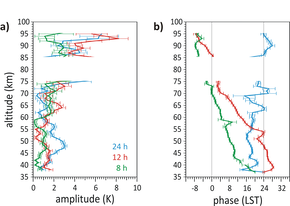Temperature tides in mid-latitudes
To the present day, there are only few lidars in the world allowing temperature measurements in the mesosphere independent of solar elevation. This is due to the enormous technical challenge reducing the high background coming from the sun.
At the IAP, a daylight capable RMR lidar was developed in addition to the daylight capable K lidar. Since April 2011 routine soundings are performed at cloud free days to determine atmospheric phenomena (NLC, temperature, tides). For example, lidar soundings allow a better temporal resolution of the tides. However, and as opposed to satellite measurements, lidar soundings do not allow the separation of the single modes of the tides.
Figure 1 shows a time series of temperature variations from a multi-day measurement (84 hours). On the left, absolute temperatures are illustrated as a function of altitude for the upper stratosphere and mesosphere (1 a). On the right, temperature deviations from the daily mean are shown to clarify the wave structures (1 b). Here, wave signatures with a downward phase progression are clearly visible across the complete altitude range.
The amplitudes and phases of the tides are calculated by harmonic analysis for each single altitude assuming different periods (8-, 12- and 24 h). Figure 2 shows the results for October 2011. Evidently, there is a dominating 24 h tide between an altitude of 40 and 60 km (~3 K at 48 km, 2a). In general, the amplitudes of the 12 h and 8 h tide increase with altitude, and are larger than the amplitude of the 24 h tide between 60 and 70 km. Above 90 km altitude, the amplitudes of the 24 h and 12 h components increase, whereas the amplitude of the 8 h tide decreases.
Figure 2 b shows the tidal phases. Regions with a downward phase progression, that means, an upward propagating wave, are found for all three components. The phase of the 24 h tide varies only slightly with altitude, which corresponds to a long vertical wavelength (> 60 km). This is consistent with the lower amplitudes at altitudes above 48 km. At altitudes above 80 km, the vertical wavelength of the 12 h tide is very short (< 20 km), except in summer. This is different from lidar soundings at other stations and topic of current research.
Due to the high temporal resolution, lidar soundings also enable the analysis of the short time variability. A first analysis has shown amplitude changes of about 100 % within a few days, especially for the short periodic tides (8 h and 12 h).
Selected publications
- K. Baumgarten, M. Gerding, G. Baumgarten und F.-J. Lübken, Temporal variability of tidal and gravity waves during a record long 10 day continuous lidar sounding, Atmos. Chem. Phys., 18, 371-384, doi:10.5194/acp-18-371-2018, 2018.














